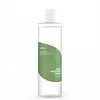What's inside
What's inside
 Key Ingredients
Key Ingredients

 Benefits
Benefits

 Ingredients Side-by-side
Ingredients Side-by-side

Aloe Barbadensis Leaf Extract
EmollientWater
Skin ConditioningMethylpropanediol
SolventPropanediol
SolventSodium Hyaluronate
HumectantCentella Asiatica Extract
CleansingPolygonum Cuspidatum Root Extract
AntioxidantScutellaria Baicalensis Root Extract
AstringentCamellia Sinensis Leaf Extract
AntimicrobialGlycyrrhiza Glabra Root
Skin ConditioningChamomilla Recutita Flower Extract
MaskingRosmarinus Officinalis Leaf Extract
AntimicrobialPolyglutamic Acid
Skin ConditioningAllantoin
Skin ConditioningDipotassium Glycyrrhizate
HumectantTrehalose
HumectantBetaine
HumectantPanthenol
Skin ConditioningTromethamine
BufferingAcrylates/C10-30 Alkyl Acrylate Crosspolymer
Emulsion StabilisingDisodium EDTA
Hydroxyacetophenone
AntioxidantAloe Barbadensis Leaf Extract, Water, Methylpropanediol, Propanediol, Sodium Hyaluronate, Centella Asiatica Extract, Polygonum Cuspidatum Root Extract, Scutellaria Baicalensis Root Extract, Camellia Sinensis Leaf Extract, Glycyrrhiza Glabra Root, Chamomilla Recutita Flower Extract, Rosmarinus Officinalis Leaf Extract, Polyglutamic Acid, Allantoin, Dipotassium Glycyrrhizate, Trehalose, Betaine, Panthenol, Tromethamine, Acrylates/C10-30 Alkyl Acrylate Crosspolymer, Disodium EDTA, Hydroxyacetophenone
Nelumbo Nucifera Flower Water
TonicWater
Skin ConditioningGlycerin
HumectantButylene Glycol
HumectantPropanediol
Solvent1,2-Hexanediol
Skin ConditioningBetaine
HumectantNelumbium Speciosum Flower Extract
Skin ConditioningNelumbo Nucifera Leaf Extract
Skin ConditioningNelumbo Nucifera Root Extract
Skin ConditioningGlyceryl Glucoside
HumectantXylitylglucoside
HumectantAnhydroxylitol
HumectantXylitol
HumectantGlucose
HumectantAllantoin
Skin ConditioningJuniperus Mexicana Oil
MaskingSodium Hyaluronate
HumectantHydroxypropyltrimonium Hyaluronate
Cynanchum Atratum Extract
Skin ConditioningMagnolia Kobus Bark Extract
Skin ConditioningHydrolyzed Hyaluronic Acid
HumectantSodium Acetylated Hyaluronate
HumectantHyaluronic Acid
HumectantSodium Hyaluronate Crosspolymer
HumectantPotassium Hyaluronate
Skin ConditioningC12-14 Pareth-12
EmulsifyingEthylhexylglycerin
Skin ConditioningXanthan Gum
EmulsifyingCitric Acid
BufferingDisodium EDTA
Sodium Citrate
BufferingNelumbo Nucifera Flower Water, Water, Glycerin, Butylene Glycol, Propanediol, 1,2-Hexanediol, Betaine, Nelumbium Speciosum Flower Extract, Nelumbo Nucifera Leaf Extract, Nelumbo Nucifera Root Extract, Glyceryl Glucoside, Xylitylglucoside, Anhydroxylitol, Xylitol, Glucose, Allantoin, Juniperus Mexicana Oil, Sodium Hyaluronate, Hydroxypropyltrimonium Hyaluronate, Cynanchum Atratum Extract, Magnolia Kobus Bark Extract, Hydrolyzed Hyaluronic Acid, Sodium Acetylated Hyaluronate, Hyaluronic Acid, Sodium Hyaluronate Crosspolymer, Potassium Hyaluronate, C12-14 Pareth-12, Ethylhexylglycerin, Xanthan Gum, Citric Acid, Disodium EDTA, Sodium Citrate
 Reviews
Reviews

Ingredients Explained
These ingredients are found in both products.
Ingredients higher up in an ingredient list are typically present in a larger amount.
Allantoin is a soothing ingredient known for its protective and moisturizingg properties. Because of this, it is often added to products with strong active ingredients.
Studies show higher concentrations of this ingredient can promote wound healing.
Though it can be derived from the comfrey plant, allantoin is produced synthetically for cosmetic products to ensure purity.
Learn more about AllantoinBetaine is a common humectant (a substance that promotes retention of moisture). It's known to be gentle on the skin and can help balance hydration.
This ingredient is best for improving hydration and soothing irritated skin. Studies also show it helps even out skin tone.
Fun fact: Betaine is naturally created in the skin and body. The kind found within cosmetic products can be either plant-derived or synthetic.
Another name for betaine is trimethylglycine.
Learn more about BetaineDisodium EDTA plays a role in making products more stable by aiding other preservatives.
It is a chelating agent, meaning it neutralizes metal ions that may be found in a product.
Disodium EDTA is a salt of edetic acid and is found to be safe in cosmetic ingredients.
Learn more about Disodium EDTAPropanediol is an all-star ingredient. It softens, hydrates, and smooths the skin.
It’s often used to:
Propanediol is not likely to cause sensitivity and considered safe to use. It is derived from corn or petroleum with a clear color and no scent.
Learn more about PropanediolSodium Hyaluronate is hyaluronic acid's salt form. It is commonly derived from the sodium salt of hyaluronic acid.
Like hyaluronic acid, it is great at holding water and acts as a humectant. This makes it a great skin hydrating ingredient.
Sodium Hyaluronate is naturally occurring in our bodies and is mostly found in eye fluid and joints.
These are some other common types of Hyaluronic Acid:
Learn more about Sodium HyaluronateWater. It's the most common cosmetic ingredient of all. You'll usually see it at the top of ingredient lists, meaning that it makes up the largest part of the product.
So why is it so popular? Water most often acts as a solvent - this means that it helps dissolve other ingredients into the formulation.
You'll also recognize water as that liquid we all need to stay alive. If you see this, drink a glass of water. Stay hydrated!
Learn more about Water